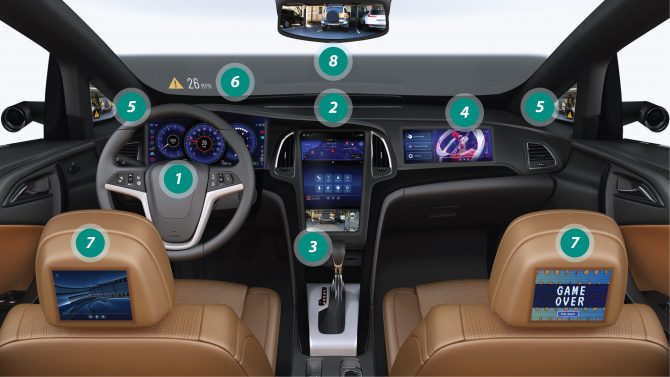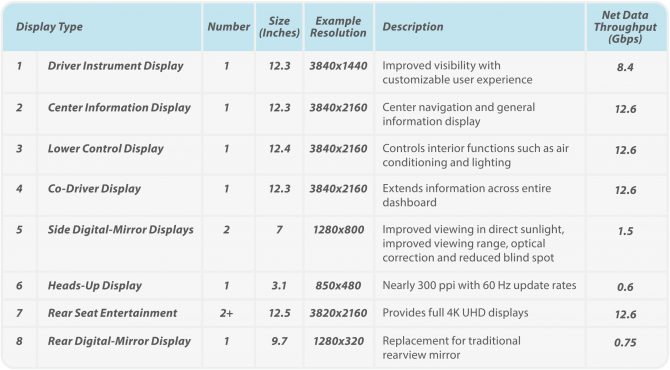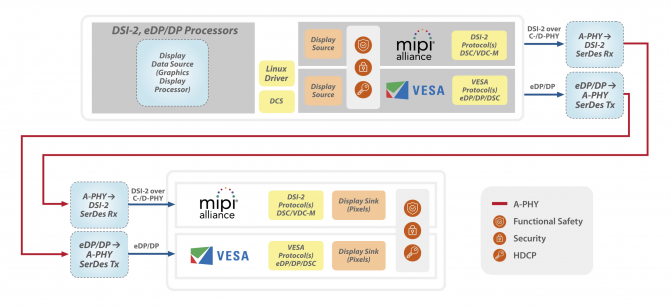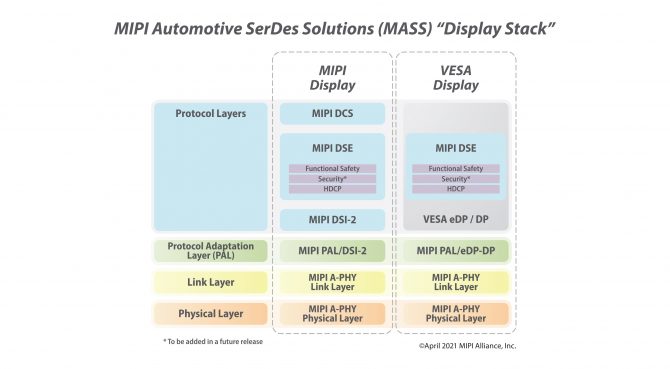
Standardized automotive display connectivity framework
By James Goel, MIPI technical steering group chair and display working group vice chair
Automation / Robotics Electronics Regulations & Standards Engineering automotive connectivity displays Editor Pick standardsEssential for future automotive electronic and electrical architectures
The automotive display connectivity challenge
Automotive display systems are currently undergoing accelerated evolution due to industry trends in connectivity, automation, sharing and electrification. Advanced driver-assistance systems (ADAS), digital cockpits, in-vehicle infotainment (IVI) and autonomous driving systems (ADS) are driving a rapid proliferation in the number of in-vehicle displays and the need for ever-increasing display resolutions, frame rates and color bit-depths.
The resultant multigigabit net data throughputs required to connect all of these displays present a significant design issue for future vehicles, requiring the development of innovative electrical and electronic (E/E) architectures that leverage the latest display technologies. These advanced display systems must also meet the stringent reliability, power, weight and electromagnetic compatibility (EMC) requirements demanded by the automotive industry.

Increasing numbers of in-vehicle displays. Source: MIPI
The use of industry standards for displays has solved similar challenges in adjacent industries such as mobile phones, and this article will explain how following a standards-based approach is also essential to solving the automotive display connectivity challenge.
Top five technical considerations for connecting automotive displays
The challenge of automotive display connectivity raises five principal technical considerations that need to be addressed when developing automotive E/E architectures:
- Bandwidth and latency: As shown in the image and table, more displays are being integrated into vehicles to support the increasing demand for ADAS and ADS —replacing traditional analog instrument clusters, mirrors and mechanical buttons, and adding new displays to support IVI services and to enable digital vehicle customization. The increasing number of displays combined with ever-increasing display resolutions, frame rates and color bit-depths will require multigigabit-per-second, ultra-low-latency connectivity, with the total net data throughput required to connect displays expected to increase significantly with each new generation of vehicles.
- Electromagnetic interference (EMI) immunity: Harsh in-vehicle environments present significant challenges to multigigabit communication technologies, which are required to operate at significantly higher symbol rates and at much higher in-band frequencies. To ensure safe and resilient operation of high-throughput data links over the vehicle’s lifespan, communications links must provide ultra-high immunity to any EMI effects by implementing noise cancellation and error correction mechanisms that target the negative effects of automotive EMI.
- Cable harness complexity: The cable harness is presently one of the heaviest and most expensive components within a vehicle. Connectivity solutions for in-vehicle displays must, wherever possible, minimize the complexity of the cable harness, reducing the cable shielding and number of conductors to a minimum to save cost and weight, and allowing use of inline connectors to enable ease of installation on the production line. Connectivity solutions must also protect against cable harness degradation due to cable aging and flexing.
- Functional safety enablers: ADAS and ADS applications must meet Automotive Safety Integrity Level (ASIL) requirements, from ASIL B through ASIL D, as defined within ISO 26262. Features that enable functional safety within display connectivity solutions to detect loss of packets, frozen links and loss of communication are essential to meet these stringent requirements.
- Engineering effort: Integrating advanced displays into vehicles can require the use of many different software and hardware components, sourced from many different vendors. Developing bespoke connectivity solutions in-house, or with a limited number of suppliers, can significantly increase engineering effort and component costs, placing the whole cost burden, including development, test and validation, onto a single automaker.
-

Example in-vehicle display types and net data throughputs. Source: MIPI
How a standardized automotive display connectivity framework can overcome these challenges
Use of a standardized automotive display connectivity framework, such as the one provided by the MIPI Automotive SerDes Solutions (MASS) display specifications, can help automakers overcome all of the challenges described above. Unlike individual specifications, which solve only one component of a display solution (such as just providing the physical layer), a framework solution provides physical and protocol layers together with key features such as display stream compression and functional safety enablers, creating a fully integrated solution for the automotive industry.
The MASS display framework, shown above, provides a complete automotive connectivity solution, incorporating a suite of industry specifications:
* MIPI A-PHY: A high-speed, low-latency (< 6μs), long-reach (up to 15m) asymmetric serializer/deserializer (SerDes) physical layer interface. A-PHY employs dynamic pulse amplitude modulation, just-in-time interference cancellers and PHY-level retransmission mechanisms to ensure ultra-high noise immunity and maximum link robustness. It supports heterogeneous point-to-point and daisy-chain display topologies and optional power delivery over a single cable (coaxial or shielded twisted pair), eliminating the need for proprietary asymmetric PHYs, simplifying in-vehicle communication networks and reducing cost, cable harness weight and development time.

MIPI Automotive SerDes Solutions (MASS) display connectivity example. Source: MIPI
* MIPI Protocol Adaptation Layers (PALs): Specifications that allow display components based on MIPI Display Serial Interface 2 (MIPI DSI-2) and VESA Embedded DisplayPort and DisplayPort (VESA eDP/DP) protocols to map their video, audio and control data to A-PHY’s A-Packet format for transmission over long-reach A-PHY networks.
* MIPI DSI-2 and VESA eDP/DP: Industry-leading display protocols to enable long-reach source-to-sink connectivity between automotive displays and their associated electronic control units. Already extensively adopted within multiple industries, including mobile, computer and automotive, use of these protocols dramatically reduces engineering effort and cost.
* MIPI Display Service Extensions (MIPI DSE): A new specification that standardizes functional safety enablers to help display solutions meet ISO 26262 requirements from ASIL B to ASIL D. Enablers include link failure detection, timeout monitoring, cyclic redundancy check to detect data transmission failures, and a message counter for replay protection. High-bandwidth Digital Content Protection (HDCP) is also enabled by DSE, and additional security features will be added in future releases.
* MIPI Display Command Set (MIPI DCS): A standardized command set for control functions and supply of data to displays using MIPI DSI-2. It specifies commands for setup, control and test functions, including the control of settings such as resolution, width and brightness, thus significantly simplifying integration and design cost.
* VESA Display Stream Compression (DSC) and VESA Display Compression-M (VDC-M): Incorporated into DSI-2, codecs that offer guaranteed low-latency performance and are visually lossless for images and videos (DSC at 8 bits-per-pixel compression and VDC-M at 5-6 bits-per-pixel compression). Already widely adopted within multiple industries, including mobile and the Internet of Things (IoT), use of these standard compression technologies for automotive display applications not only massively reduces connectivity bandwidth, but also dramatically reduces engineering effort and cost.

MIPI Automotive SerDes Solutions (MASS) display specifications. Source: MIPI
Conclusion
Use of industry standards such as MASS solves key automotive display connectivity challenges, drives interoperability between different vendor solutions and leverages economies of scale by amortizing engineering costs over larger volumes of components spread across the whole industry. Most importantly for automakers, the use of standards removes the burden of designing (or selecting) a proprietary interface for the next E/E architectures, allowing automakers to focus on “higher-value,” product-differentiating technologies that sit higher up the protocol stack.
—————————-
This article was written and submitted by James Goel, MIPI technical steering group chair and display working group vice chair. Read more about the MIPI Automotive SerDes Solutions display framework.
